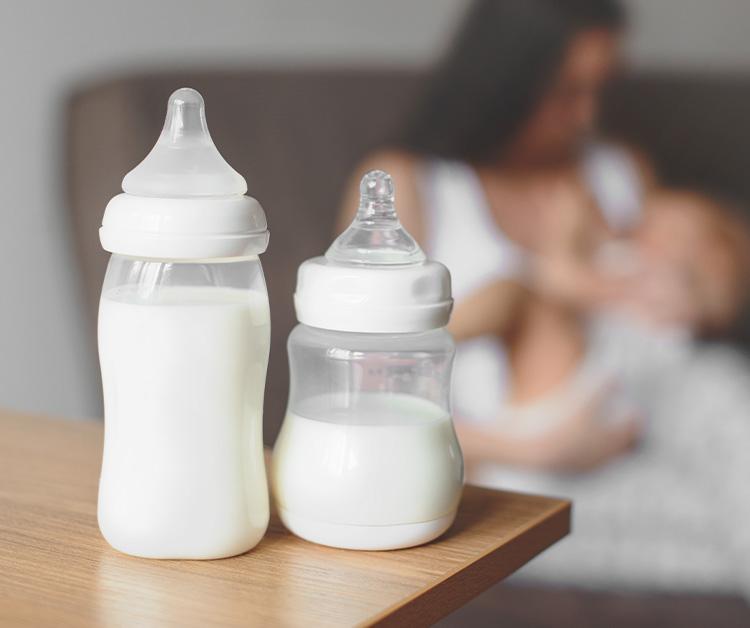Due to maintenance, rewards points for receipt uploads will be delayed. Thank you for your patience!

Feeding your baby is deeply personal—and not always simple or straightforward. Breastfeeding is a beautiful and natural way to nourish your baby, but can be a little unpredictable. Parents may face challenges with milk production, discomfort and busy schedules. Combination feeding, also known as “mixed feeding,” and “breastfeeding supplementation,” is embraced by many parents as a way to help make the difficult days easier, to allow more breaks between feedings, and as a backup plan for times when breastfeeding isn’t feasible.

Enfamil Optimum, our closest infant formula to breastmilk, is one of our most popular choices
among parents who combo feed.
Combination feeding is a model of feeding your baby a combination of breast milk and infant formula. There are many reasons why parents may choose to combo feed, whether it’s to:
In the early weeks, breastfeeding or pumping 8-12 times per day helps establish a strong supply. However, as your milk production stabilizes, you may be able to adjust the frequency based on your baby’s needs and how much formula they are receiving.
Learn more about common breastfeeding challenges and how to overcome them.
Creating a combination feeding schedule can help keep things organized and ensure your baby gets the right amount of nourishment. Remember that babies are unique, and their feeding patterns can change over time. Be flexible and adapt to your baby's needs. It's all about finding a feeding routine that suits both of you.
No, combination feeding itself doesn’t directly cause colic or tummy troubles, but changes in a baby’s feeding routine—such as introducing a new formula—may come with an adjustment period. Some babies may need time to adjust to a new feeding method, especially if their digestive system is sensitive, in which case you might consider looking into gentle formulas, such as Enfamil Optimum Gentlease that are made with easy-to-digest proteins and inspired by breastmilk; designed to help fussiness, gas, and crying in 24 hours. You can get the trusted nutrition of Enfamil Optimum in a formula designed for babies with sensitive tummies!
Nipple confusion happens when a baby has difficulty switching between breastfeeding and bottle feeding due to differences in how milk flows and how they latch. Bottles typically have a faster, more consistent flow than the breast, which can lead some babies to prefer the bottle and become frustrated with breastfeeding. Others may need some time to adjust between the different sucking techniques and flows for each.
To help avoid nipple confusion, you can try:
It’s not uncommon for any parenting decision to be questioned by others, and sometimes other people don’t share their opinions or feedback in the most helpful of ways. This can create unnecessary pressure and guilt for you and many other parents. If you experience judgment:
When it comes to baby formula, there are various options available, and our family of formulas guide can help you explore all your options with Enfamil. We’re proud to be the #1 trusted brand by pediatricians and parents, feeding millions of babies every day.
Our ready-to-use formula is a quick, convenient option that parents LOVE especially for nighttime feeding, travel, and managing busy schedules. Optimum RTU offers balanced nutrition without the hassle of mixing. It’s crafted to be our closest to breastmilk, and has key ingredients for immune support, brain development, and growth.
Whether you choose to breastfeed, formula feed, or a combination of both, what matters most is nourishing your baby with love—and understanding all your options along the way. That’s where Enfamil Family Beginnings® comes in.
As a member, you’ll get personalized support for your feeding journey, including:
Join Enfamil Family Beginnings® today—it’s free, and designed to support you every step of the way.
All information on Enfamil, including but not limited to information about health, medical conditions, and nutrition, is intended for your general knowledge and is not a substitute for a healthcare professional's medical identification, advice, or management for specific medical conditions. You should seek medical care and consult your doctor or pediatrician for any specific health or nutrition issues. Never disregard professional medical advice or delay seeking medical treatment, care, or help because of information you have read on Enfamil.